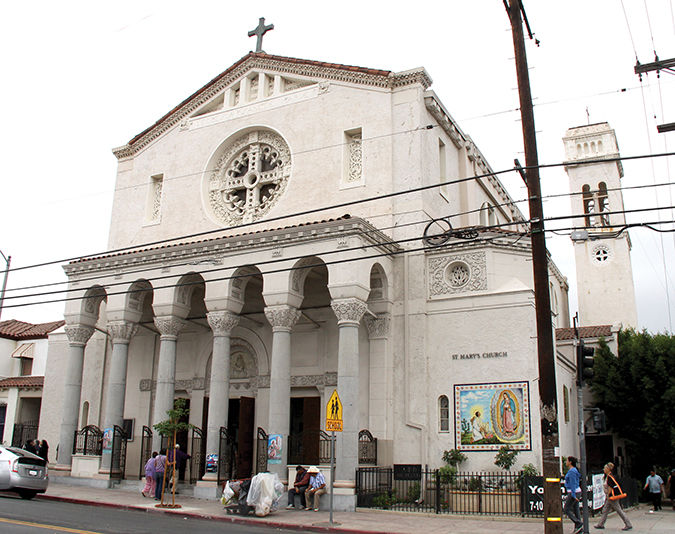In the years California was part of Mexico, the neighborhood just east of downtown Los Angeles (or whatever “downtown” existed in the early 19th century) was called Paredon Blanco (White Bluff). As an agricultural region on the east side of the bridge-less Los Angeles River, it was populated mainly by immigrant Mexicans and Native Americans (San Gabrielinos).
Then in 1858, San Francisco businessman Andrew Boyle, invited by a friend to visit the area, was enough impressed by the region’s fertile land that he not only bought a good portion of it, he became (by all indications) the first Anglo to live there, building a house near today’s Boyle and Third Streets. He died in 1871, whereupon his friend William Workman named the area Boyle Heights.
Over time, the area became racially and ethnically diverse, with Irish railroad workers, Central American refugees and immigrant Jews and Japanese among the Latino population that remains the dominant community today.
The first Catholic parish created to serve the neighborhood, named for the Blessed Mother, was established Nov. 10, 1896 by Bishop George Montgomery, with the first “stout red brick” church at the corner of Fourth and Chicago Streets dedicated Nov. 14, 1897. The founding pastor was Father Joseph Doyle, who became ill and resigned in 1900; he died while en route to Ireland in 1901.
His successor, Father Joseph Barron, began the Holy Names Society in 1904 and brought the Sisters of the Holy Names to open and staff St. Mary School — the third in the archdiocese — in 1907. Father Barron died of an illness in 1910.
The first parish hall, a large rambling wood structure known affectionately as “the barn,” opened in 1913 (to be replaced in 1961 by the current structure). This was accomplished under the leadership of Father Joseph McManus, who in 1918 moved to Holy Cross in South L.A. as pastor, but died in 1920.
Father John Gallagher served briefly as pastor, succeeded in 1919 by a former St. Mary’s associate, Father Thomas O’Reagan, who served until 1937. It was under Father O’Reagan that a new and larger Italian Byzantine-style St. Mary Church, designed by Thomas Franklin Power and sporting a 100-foot-tall bell tower, was dedicated in 1926 by Bishop John Cantwell, as post-World War I prosperity invigorated the neighborhood.
But the Depression and World War II forced the parish to carry a weighty debt until it was paid off in 1950 under the pastorate of Msgr. Thomas O’Dwyer. For many parishioners, it was all they could do to survive day-to-day through the Depression, with some families doubling- and tripling-up to share homes.
As the parish and community rebounded post-WWII, St. Mary School was rebuilt in 1950, and in 2007 marked its 100th anniversary, with alumni from eight decades represented — among them, Rep. Lucille Roybal-Allard, class of 1955. In addition to the Holy Names Sisters, the Daughters of Charity, the Salesian Sisters and the Daughters of Mary Help of Christians have served the school.
Following the five-year pastorate of Msgr. James Dessert, the archdiocese in 1965 gave administration of St. Mary’s to the care of the Salesians of Don Bosco, with Father Albert Negri the first Salesian pastor. A native of northern Italy and the last Salesian pastor of St. Patrick’s in L.A., he died in 1971 at age 53.
He had been succeeded in 1968 by Father Charles Farina, born in Milan, Italy, and a former faculty member at Bishop Mora Salesian High School a short distance from St. Mary’s. He oversaw the parish’s 75th anniversary in 1971, at which St. Mary’s highlighted the fact that 13 priests and 39 nuns had come from the parish.
But on Oct. 1, 1987, the Whittier Narrows earthquake forced Father Avelino Lorenzo, then-pastor, to hurry worshippers out of the church, with an after-shock causing much of the ceiling to fall in a place where people had been praying not many minutes before.
Nearly $770,000 in costs (for repairs and reinforcement compliance) faced the economically challenged parish. Somehow, funds were raised from within and outside the community, and “The Grand Old Lady of Boyle Heights” celebrated its centennial in November 1997, under the leadership of Father Jim Nieblas, a ninth-generation Californian who grew up in Mission San Juan Capistrano parish.
“I know what it means to take pride of ownership in your parish,” Father Jim told The Tidings. “My hope is that this same pride will be instilled among the parishioners of St. Mary’s for many years to come. And I don’t think that will be a problem.”
Established: Nov. 10, 1896
Location: 407 S. Chicago St., Los Angeles (Boyle Heights)
San Gabriel Region: Deanery 9
Interested in more? Subscribe to Angelus News to get daily articles sent to your inbox.

